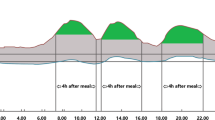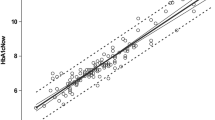Abstract
Objective
We evaluated the relationship between glycated hemoglobin (HbA1c) in diabetic patients with stable glycemic control and the average fasting blood glucose (FBG) and postprandial blood glucose (PPG) values of 4 weeks prior to HbA1c measurement and compared the results with glycated albumin (GA).
Research design and methods
Fifty-one diabetic patients were asked to use self-monitoring blood glucose to measure FBG before breakfast and PPG 1 and 2 h after breakfast 1 day a week for 4 weeks while maintaining normal daily activities. During monthly outpatient visits, HbA1c and GA were measured. Data were analyzed in 40 patients, with <1% variation in HbA1c values over 4 months.
Results
HbA1c was best predicted by the average FBG (AvFBG) and the average of 1-h and 2-h PPG (AvMPPG) (adjusted R 2 = 0.51; HbA1c = 4.35 + 0.013 AvFBG + 0.0056 AvMPPG). The contribution ratio was 0.013:0.0056, showing about 2.3 times greater contribution by FBG. GA was best predicted by the AvFBG and the average of 2-h PPG (Av2hPPG) (adjusted R 2 = 0.55; GA = 9.36 + 0.0241 AvFBG + 0.0430 Av2hPPG). The contribution ratio was 0.024:0.043, showing about 1.8 times greater contribution by 2-h PPG. This converse contribution of fasting and postprandial glucose to HbA1c and GA was more prominent in insulin-treated patients than in untreated patients.
Conclusions
HbA1c and GA can be satisfactorily predicted by FBG and PPG. HbA1c reflects FBG more so than PPG, whereas GA better reflects PPG. Thus, depending on the characteristics of the glycated protein, a different glycemic status is reflected.



Similar content being viewed by others
References
Hanefeld M, Fischer S, Julius U, Schulze J, Schwanebeck U, Schmechel H, Ziegelasch HJ, Lindner J. Risk factors for myocardial infarction and death in newly detected NIDDM: the Diabetes Intervention Study, 11-year follow-up. Diabetologia. 1996;39:1577–83.
Glucose tolerance and mortality: comparison of WHO and American Diabetes Association diagnostic criteria. The DECODE study group. European Diabetes Epidemiology Group. Diabetes Epidemiology: Collaborative analysis of diagnostic criteria in Europe. Lancet. 1999;354:617–621.
Tominaga M, Eguchi H, Manaka H, Igarashi K, Kato T, Sekikawa A. Impaired glucose tolerance is a risk factor for cardiovascular disease, but not impaired fasting glucose. The Funagata Diabetes Study. Diabetes Care. 1999;22:920–4.
Avignon A, Radauceanu A, Monnier L. Nonfasting plasma glucose is a better marker of diabetic control than fasting plasma glucose in type 2 diabetes. Diabetes Care. 1997;20:1822–6.
Bonora E, Calcaterra F, Lombardi S, Bonfante N, Formentini G, Bonadonna RC, Muggeo M. Plasma glucose levels throughout the day and HbA1C interrelationships in type 2 diabetes: implications for treatment and monitoring of metabolic control. Diabetes Care. 2001;24:2023–9.
Monnier L, Lapinski H, Colette C. Contributions of fasting and postprandial plasma glucose increments to the overall diurnal hyperglycemia of type 2 diabetic patients: variations with increasing levels of HbA1C. Diabetes Care. 2003;26:881–5.
Derr R, Garrett E, Stacy GA, Saudek CD. Is HbA1C affected by glycemic instability? Diabetes Care. 2003;26:2728–33.
Boland E, Monsod T, Delucia M, Brandt CA, Fernando S, Tamborlane WV. Limitations of conventional methods of self-monitoring of blood glucose: lessons learned from 3 days of continuous glucose sensing in pediatric patients with type 1 diabetes. Diabetes Care. 2001;24:1858–62.
Salardi S, Zucchini S, Santoni R, Ragni L, Gualandi S, Cicognani A, Cacciari E. The glucose area under the profiles obtained with continuous glucose monitoring system relationships with HbA1C in pediatric type 1 diabetic patients. Diabetes Care. 2002;25:1840–4.
Kohnert KD, Augstein P, Heinke P, Zander E, Peterson K, Freyse EJ, Salzsieder E. Chronic hyperglycemia but not glucose variability determines HbA1c levels in well-controlled patients with type 2 diabetes. Diabetes Res Clin Pract. 2007;77:420–6.
Inaba M, Okuno S, Kumeda Y, Yamada S, Imanishi Y, Tabata T, Okamura M, Okada S, Yamakawa T, Ishimura E, Nishizawa Y, Osaka CKD Expert Research Group. Glycated albumin is a better glycemic indicator than glycated hemoglobin values in hemodialysis patients with diabetes: effect of anemia and erythropoietin injection. J Am Soc Nephrol. 2007;18:896–903.
Hashimoto K, Noguchi S, Morimoto Y, Hamada S, Wasada K, Imai S, Murata Y, Kasayama S, Koga M. A1C but not serum glycated albumin is elevated in late pregnancy owing to iron deficiency. Diabetes Care. 2008;31:1945–8.
Tahara Y, Shima K. Kinetics of HbA1c, glycated albumin, and fructosamine and analysis of their weight functions against preceding plasma glucose level. Diabetes Care. 1995;18:440–7.
Takahashi S, Uchino H, Shimizu T, Kanazawa A, Tamura Y, Sakai K, Watada H, Hirose T, Kawamori R, Tanaka Y. Comparison of glycated albumin (GA) and glycated hemoglobin (HbA1c) in type 2 diabetic patients: usefulness of GA for evaluation of short-term changes in glycemic control. Endocr J. 2007;54:139–44.
Kouzuma T, Uemastu Y, Usami T, Imamura S. Study of glycated amino acid elimination reaction for an improved enzymatic glycated albumin measurement method. Clinical Chimca Acta. 2004;346:135–43.
Bonora E, Corrao G, Bagnardi V, Ceriello A, Comaschi M, Montanari P, Meigs JB. Prevalence and correlates of post-prandial hyperglycaemia in a large sample of patients with type 2 diabetes mellitus. Diabetologia. 2006;49:846–54.
Borg R, Kuenen J, Carstensen B, Zheng H, Nathan D, Heine R, Nerup J, Johnsen K, Witte D, on behalf of the ADAG study Group. Associations between features of glucose exposure and A1C, the A1C-Derived Average Glucose (ADAG) Study. Diabetes. 2011;54(1):69–72.
Yoshiuchi K, Matsuhisa M, Katakami N, Nakatani Y, Sakamoto K, Matsuoka T, Umayahara Y, Kosugi K, Kaneto H, Yamasaki Y, Hori M. Glycated albumin is a better indicator for glucose excursion than glycated hemoglobin in type 1 and type 2 diabetes. Endocr J. 2008;55:503–7.
Koga M, Murai J, Saito H, Kasayama S. Glycated albumin and glycated hemoglobin are influenced differently by endogenous insulin secretion in patients with type 2 diabetes. Diabetes Care. 2010;33:270–2.
Suwa T, Ohta A, Matsui T, Koganei R, Kato H, Kawata T, Sada Y, Ishii S, Kondo A, Murakami K, Katabami T, Tanaka Y. Relationship between clinical markers of glycemia and glucose excursion evaluated by continuous glucose monitoring (CGM). Endocr J. 2010;57:135–40.
Monnier L, Colette C, Dunseath GJ, Owens DR. The loss of postprandial glycemic control precedes stepwise deterioration of fasting with worsening diabetes. Diabetes Care. 2007;30:263–9.
Monnier L, Colette C, Rabasa-Lhoret R, Lapinski H, Caubel C, Avignon A, Boniface H. Morning hyperglycemic excursions: a constant failure in the metabolic control of non-insulin-using patients with type 2 diabetes. Diabetes Care. 2002;25:737–41.
Day JF, Ingebretsen CG, Ingebretsen WR Jr, Baynes JW, Thorpe SR. Nonenzymatic glucosylation of serum proteins and hemoglobin: response to changes in blood glucose levels in diabetic rats. Diabetes. 1980;29:524–7.
Acknowledgments
The costs for this study were allocated from the research expenses of Social Insurance Central General Hospital. The authors are grateful to Ms. Tomoko Chikami, Ms. Kazuko Mochizuki, and Ms. Satomi Ishida for their technical assistance. Parts of this study were presented in abstract and poster form at the 68th Scientific Sessions of the American Diabetes Association, San Francisco, California, 6–8 June 2008.
Author information
Authors and Affiliations
Corresponding author
About this article
Cite this article
Sakuma, N., Omura, M., Oda, E. et al. Converse contributions of fasting and postprandial glucose to HbA1c and glycated albumin. Diabetol Int 2, 162–171 (2011). https://doi.org/10.1007/s13340-011-0036-9
Received:
Accepted:
Published:
Issue Date:
DOI: https://doi.org/10.1007/s13340-011-0036-9




